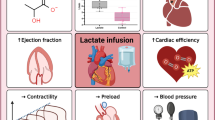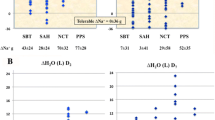Abstract
Objective
To determine whether noradrenaline, adrenaline and dopamine have persistent on\(\dot VO_2 \) and metabolism.
Design
Descriptive laboratory investigation.
Setting
Laboratory of the Department of Anaesthesiology at a University Hospital.
Subjects
9 volunteers.
Intervention
\(\dot VO_2 \) and the plasma concentration of glucose and free fatty acids were measured prior to and during a 4 h infusion of saline (control), noradrenaline (0.14 μg/kg min) adrenaline (0.08 μg/kg min) or dopamine (7 μg/kg min),n=9 each.\(\dot VO_2 \) was measured using an open circuit gas exchange system.
Measurements and main results
\(\dot VO_2 \) increased from 250±22 ml/min to 280±38 ml/min during noradrenaline, to 298±30 ml/min during adrenaline and to 292±39 ml/min during dopamine infusion. The plasma glucose concentration increased from 6.2±0.6 mmol/l to 8.8±0.8 mmol/l, 13.2±1.4 and 7.3±0.4 mmol/l during infusion of noradrenaline, adrenaline or dopamine, respectively. The plasma free fatty acid concentration increased from 0.28±0.10 mmol/l to 0.79±0.21 mmol/l during noradrenaline and to 0.52±0.09 mmol/l during dopamine. In contrast, free fatty acid values averaged baseline values at the end of the adrenaline infusion after an initial increase to 0.72±0.31 mmol/l.
Conclusions
Administration of noradrenaline, adrenaline or dopamine resulted in persistent increases in\(\dot VO_2 \) in volunteers. With the exception of the transient adrenaline effect on fatty acids the metabolic actions were steady during 4 h of adrenergic stimulation. Since the adrenergic effect on\(\dot VO_2 \) is persistent over time a similar action in patients (e.g. septic shock) during treatment with adrenoceptor agonists may be important. Thus, an increase in\(\dot VO_2 \) during therapy may not only reflect an oxygen debt but also a pharmacodynamic action of adrenoceptor mediated calorigenic and metabolic induction.
Similar content being viewed by others
References
Shoemaker WC, Appel PL, Kram HB, Waxman K, Lee T-S (1988) Prospective trial of supranormal values of survivors as therapeutic goals in high-risk surgical patients. Chest 94:1176–1186
Boyd O, Grounds RM, Bennett ED (1992) The beneficial effect of supranormalization of oxygen delivery with dopexamine hydrochloride on perioperative mortality. Intensive Care Med 18 [Suppl 2]: S72
Edwards JD, Brown GCS, Nightingale P, Slater RM, Faragher EB (1989) Use of survivors' cardiorespiratory values as therapeutic goals in septic shock. Crit Care Med 17:1098–1103
Tuchschmidt J, Fried J, Astiz M, Rackow E (1992) Elevation of cardiac output and oxygen delivery improves outcome in septic shock. Chest 102:216–220
Sjöström L, Schutz Y, Gudinchet F, Hegnell L, Pittet PG, Jequier E (1983) Epinephrine sensitivity with respect to metabolic rate and other variables in women. Am J Physiol 245:E431-E442
Katzeff HL, O'Connell M, Horton ES, Danforth E, Young JB, Landsberg L (1986) Metabolic studies in human obesity during overnutrition and undernutrition: thermogenic and hormonal response to norepinephrine. Metabolism 35:166–175
Regan CJ, Duckworth R, Fairhurst JA, Maycock PF, Frayn KN, Campbell IT (1990) Metabolic effects of low-dose dopamine infusion in normal volunteers. Clin Sci 79:605–611
Green CJ, Frazer RS, Underhill S, Maycock P, Fairhurst JA, Campbell IT (1992) Metabolic effects of dobutamine in normal man. Clin Sci 82:77–83
Ensinger H, Weichel T, Lindner KH, Grünert A, Ahnefeld FW (1993) Effects of norepinephrine, epinephrine, and dopamine infusions on oxygen consumption in volunteers. Crit Care Med 21:1502–1508
Bihari D, Smithies M, Gimson A, Tinker J (1987) The effects of vasodilation with prostacyclin on oxygen delivery and uptake in critically ill patients. N Engl J Med 317:397–403
Vincent JL, Roman A, De Backer D, Kahn RL (1990) Oxygen uptake/supply dependency. Am Rev Respir Dis 142: 2–7
Rizza RA, Haymond MW, Cryer PE, Gerich JE (1979) Differential effects of epinephrine on glucose production and disposal in man. Am J Physiol 237: E356-E362
Galster AD, Clutter WE, Cryer PE, Collins JA, Bier DM (1981) Epinephrine plasma thresholds for lipolytic effects in man. J Clin Invest 67: 1729–1738
Takala J, Keinanen O, Vaisanen P, Kari A (1989) Measurements of gas exchange in intensive care: laboratory and clinical validation of a new device. Crit Care Med 17:1041–1047
Grünert A (1975) Die mikroanalytische, selektive Bestimmung der unveresterten langkettigen Fettsäuren im Serum. Z Klin Chem Klin Biochem 13:407–412
Beischer W, Keller L, Maas M, Schiefer E, Pfeiffer EF (1975) Human C-peptide. Part I: Radioimmunoassay. Klin Wochenschr 54:709–715
Melani F, Ditschuneit H, Bartelt KM, Friedrich H, Pfeiffer EF (1965) Über die radioimmunologische Bestimmung von Insulin im Blut. Klin Wochenschr 43:1000–1007
Unger RH, Eisentraut AM, McCall MS, Keller S, Lanz HC, Madison LL (1959) Glucagon antibodies and their use for immunoassay for glucagon. Proc Soc Exp Biol 102:621–623
Wolfe RR, Allsop JR, Burke JF (1979) Glucose metabolism in man: responses to intravenous glucose infusion. Metabolism 28:210–220
Kohli JD, Glock D, Goldberg LI (1983) Selective DA 2 versus DA 1 antagonist activity of domperidone in the periphery. Eur J Pharmacol 89:137–141
Laduron PM, Leysen JE (1979) Domperidone, a specific in vitro dopamine antagonist, devoid of in vivo central dopaminergic activity. Biochem Pharmacol 28:2161–2165
Ensinger H, Majewski H, Hedler L, Starke K (1985) Neuronal and postjunctional components in the blood pressure effects of dopamine and bromocriptine in rabbits. J Pharmacol Exp Ther 234:681–690
Manelli M, Pupilli C, Fabri G, Musante R, de Feo ML, Franchi F, Giusti G (1988) Endogenous dopamine (DA) and DA2 receptors: a mechanism limiting excessive sympathetic-adrenal discharge in humans. J Clin Endocrinol Metab 66:626–631
Girbes AJR, van Veldhuisen DJ, Grevink RG, Smit AJ, Reitsma WD (1992) Effects of ibopamine on exercise-induced increase in norepinephrine in normal man. J Cardiovasc Pharmacol 19:371–374
Ruttimann Y, Chiolero R, Jecquier E, Breitenstein E, Schutz Y (1989) Effects of dopamine on total oxygen consumption and oxygen delivery in healthy men. Am J Physiol 257:E541-E546
Lansberg L, Saville ME, Young JB (1984) Sympathoadrenal system and regulation of thermogenesis. Am J Physiol 247:E181-E189
Sacca L, Morrone G, Cicala M, Corso G, Ungaro B (1980) Influence of epinephrine, norepinephrine, and isoproterenol on glucose homeostasis in normal man. J Clin Endocrinol Metab 50: 680–684
Issekutz B, Shaw WAS, Issekutz TB (1975) Effect of lactate of FFA and glycerol turnover in resting and exercising dogs. J Appl Physiol 39:349–353
Wilmore DW, Long JM, Mason AD, Skreen RW, Pruitt BA (1974) Catecholamines: mediator of the hypermetabolic response to thermal injury. Ann Surg 180:653–668
Wolfe RR, Herndon DN, Jahoor F, Miyoshi H, Wolfe M (1987) Effect of severe burn injury on substrate cycling by glucose and fatty acids. N Engl J Med 317:403–408
Gilbert EM, Haupt MT, Mandanas RY, Huaringa AJ, Carlson RW (1986) The effect of fluid loading, blood transfusion, and catecholamine infusion on oxygen delivery and consumption in patients with sepsis. Am Rev Respir Dis 134:873–878
Neviere R, Mathieu D, Herengt F, Wattel F (1992) Does oxygen supply dependency reflect tissue oxygen debt? Intensive Care Med 18 [Suppl 2]:S40
Backer Dde, Berre J, Zhang H, Vincent JL (1992) Effects of prostacyclin vs dobutamine on the VO2/DO2 relationship in septic patients. Intensive Care Med 18 [Suppl 2]:S99
Silverman HJ, Tuma P (1992) Gastric tonometry in patients with sepsis. Effects of dobutamine infusions and red packed blood cell transfusion. Chest 102:184–188
Palazzo MG, Suter PM (1991) Delivery dependent oxygen consumption in patients with septic shock: daily variations, relationship with outcome and the sick-euthyroid syndrome. Intensive Care Med 17:325–332
Ronco JJ, Phang PT, Walley KR, Wiggs b, Fenwick JC, Russel JA (1991) Oxygen consumption is independent of changes in oxygen delivery in severe respiratory distress syndrome. Am Rev Respir Dis 143:1267–1273
Carlile PV, Gray BA (1989) Effect of opposite changes in cardiac output and arterial pO2 on the relationship between mixed venous pO2 and oxygen transport. Am Rev Respir Dis 140: 891–898
Annat G, Viale JP, Percival C, Froment M, Motin J (1986) Oxygen delivery and uptake in the adult respiratory distress syndrome. Lack of relationship when measured independently in patients with normal blood lactate concentrations. Am Rev Respir Dis 133: 999–1001
Takala J, Ruokonen E (1992) Underlying disease modified the response of regional blood flow to dobutamine. Crit Care Med 20 [Suppl]:114
Author information
Authors and Affiliations
Rights and permissions
About this article
Cite this article
Ensinger, H., Weichel, T., Lindner, K.H. et al. Are the effects of noradrenaline, adrenaline and dopamine infusions on\(\dot VO_2 \) and metabolism transient?and metabolism transient?. Intensive Care Med 21, 50–56 (1995). https://doi.org/10.1007/BF02425154
Received:
Accepted:
Issue Date:
DOI: https://doi.org/10.1007/BF02425154




